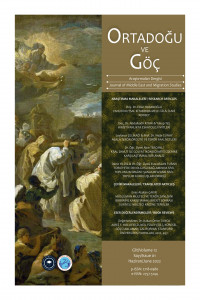Öz
Samuel-I kitabındaki bilgilere göre genç bir çoban iken Filistiler ile İsrailoğulları arasındaki savaşa kendi istediğiyle dâhil olan Hz. Davut (M.Ö. 1010-940), İsrail halkına meydan okuyan iri cüsseli Golyat adındaki savaşçıya karşı çıkmıştır. Düşmanın saldırısını ustaca savuşturan genç Davut, elindeki sapanla alnının ortasından vurarak Golyat’ı önce yere sermiş ardından da onun üzerine çıkarak kılıçla başını kesmiştir. Meydan okuma vasıtasıyla gerçekleşen bu hadise Davut’un askeri ve siyasi kariyerini de başlatmıştır. Tasvir sanatları açısından özellikle Avrupa resminde çok geniş yer tutan bu ikonografik konu hem Tevrat hem de Kur’an-ı Kerim’de detaylı bir şekilde açıklanmaktadır. İki din arasındaki ortak ikonografik metni dikkatli bir şekilde analiz ettiğimizde tek farkın Hz. Davut yerine “Kral David” Golyat yerine de “Câlût” denmesiyle sınırlı olmadığı bir başka ifade ile kutsal anlatılardaki tek farkın “isim değişikliği” olmadığı görülür. Orta doğu kaynaklı iki dinin, aynı ikonografik metinleri farklı yorumlamasıyla başlayan değişimler, İslamiyet’in kutsal kişiliklerin tasvirini yasaklayan genel tutumu ve Hristiyanlığın bu konudaki “serbest” yaklaşımı sanat açısından konunun daha farklı bir zeminde ilerlemesine doğrudan olanak sağlamıştır. Biz de bu çalışmamızda semavi dinlerin kutsal olarak kabul ettiği ancak sadece İslamiyet’in “Peygamber” sıfatıyla benimsediği Hz. Davut’un tarih sahnesine çıkmasına sebep olan bir mücadeleyi ikonografik açıdan karşılaştırmalı bir şekilde ele alacağız. Çalışmamızın temel amacı Hz. Davut ve Golyat ikonografisinin dinler arasındaki metinsel farklılıkları ve bu farklılıkların sanatsal izdüşümlerini incelemektir.
Anahtar Kelimeler
Kaynakça
- Skolnik, F. (2007). “David”, Encyclopaedia Judaica, Detroit.
- Louise, C. S. (2009). Anicent World Leaders: King David, New York. Mckenzie, M. (2000). King David A Biography, New York.
- Küçük, A., Tümer, G., Küçük, A. M. (2018). Dinler Tarihi, Ankara.
- TERCANLI, Akın "Bernardo Strozzi Resimlerinde Davut ve Golyat İkonografisi", Kilis 7 Aralık Üniversitesi Sosyal Bilimler Enstitüsü Sosyal Bilimler Dergisi, Journal of Social Sciences, 2019, 9(18), s. 163-185.
Öz
According to the information in the book of Samuel-I, Prophet David (1010-940 BC), who was involved in the war between the Philistines and Israelis voluntarily when he was a young shepherd, flied in the face of the big-bodied warrior named Goliath who challenged the people of Israel. Fending off the attacks of the enemy skillfully, young David struck Goliath in the middle of the forehead with the sling in his hand knocking Goliath down, and then climbed on top of him and cut off his head with a sword. This event, which took place through the challenge, also jumpstarted David's military and political career. This iconographic subject, which has a very large place in European painting in terms of pictorial arts, is explained in detail in both the Torah and the Qur'an. When we analyze the texts of the two religions carefully in terms of the iconographic similarities between them, it is seen that the difference is not limited to the naming of “King David” instead of Prophet David and “Cālūt” instead of Goliath, in other words, the “name difference” is not the only difference in the sacred narratives. The changes that started with the different interpretations of the same iconographic texts by two religions originating from the Middle East, the general attitude of Islam that prohibits the depiction of holy personalities, and the “free” approach of Christianity on this issue directly allowed the subject to progress on a different ground in terms of art. In this study, we will discuss the struggle that led to the appearance of Prophet David, whom the monotheistic religions considered sacred but only as the “Prophet” in Islam, to appear on the stage of history in an iconographically comparative way. The main purpose of our study is to examine the textual differences between religions and the artistic projections of these differences on the iconography of Prophet David and Goliath.
Anahtar Kelimeler
Kaynakça
- Skolnik, F. (2007). “David”, Encyclopaedia Judaica, Detroit.
- Louise, C. S. (2009). Anicent World Leaders: King David, New York. Mckenzie, M. (2000). King David A Biography, New York.
- Küçük, A., Tümer, G., Küçük, A. M. (2018). Dinler Tarihi, Ankara.
- TERCANLI, Akın "Bernardo Strozzi Resimlerinde Davut ve Golyat İkonografisi", Kilis 7 Aralık Üniversitesi Sosyal Bilimler Enstitüsü Sosyal Bilimler Dergisi, Journal of Social Sciences, 2019, 9(18), s. 163-185.
Ayrıntılar
| Birincil Dil | Türkçe |
|---|---|
| Konular | Din Araştırmaları |
| Bölüm | ARAŞTIRMA MAKALELERİ |
| Yazarlar | |
| Yayımlanma Tarihi | 30 Haziran 2022 |
| Yayımlandığı Sayı | Yıl 2022 Cilt: 12 Sayı: 1 |


